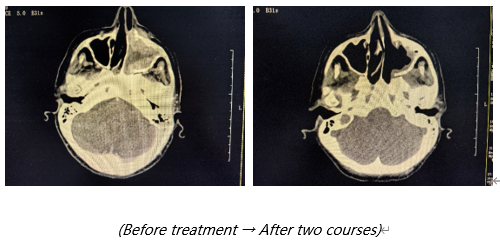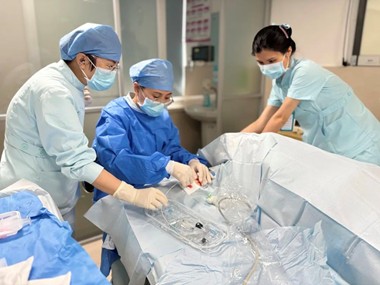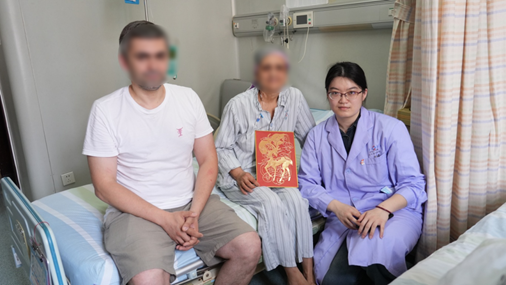“Look! My nose is finally clear again!” Maka (alias) excitedly pointed to her nose, showing the medical staff the long-awaited improvement. She came from Kazakhstan in Central Asia, her smile radiating a sense of long-lost relief.
Just a few months ago, persistent nasal congestion, repeated nosebleeds, and a loss of smell were constant burdens in her daily life. Her story began in January 2025.
At that time, Maka started to suffer from persistent pain in the left maxillofacial region, a foreign body sensation when swallowing, and occasional blood in her nasal discharge. Examination at her local hospital revealed a “space-occupying lesion in the left maxillary sinus.” Post-surgical pathology suggested a maxillary sinus teratocarcinosarcoma.
However, less than two months after surgery, her left facial pain worsened, and a new mass appeared inside her nasal cavity. Highly suspicious of malignancy, Maka traveled to Moscow for further evaluation. A biopsy there confirmed the diagnosis: olfactory neuroblastoma. Doctors in Moscow advised her to return home for chemotherapy.
Olfactory Neuroblastoma
Olfactory neuroblastoma is a rare malignant tumor that originates in the olfactory epithelium located at the top of the nasal cavity. Its early symptoms are nonspecific, often presenting as nasal congestion and epistaxis (nosebleeds). As the disease progresses, it may lead to loss of smell, headaches, or even impaired eye movement.
Although olfactory neuroblastoma is highly sensitive to radiotherapy, it is also prone to recurrence at the primary site. Therefore, the current clinical approach often involves surgery combined with radiotherapy, sometimes with the addition of chemotherapy. Selected patients may also benefit from preoperative induction chemotherapy or preoperative radiotherapy.
For Maka, the tumor brought severe breathing difficulties, persistent nosebleeds, and unrelenting headaches, leaving her exhausted both physically and mentally. On the recommendation of a friend, she learned about Fuda Cancer Hospital in Guangzhou, which has a strong reputation for treating complex tumors. Holding onto her last hope, she traveled to Guangzhou with her family and was admitted to Fuda’s Medical Oncology Department III.
A Precise Multidisciplinary Treatment Plan
Upon admission, Maka’s nasal cavity was almost completely obstructed by the tumor, which had extensively invaded the nasopharynx, left ethmoid sinus, and maxillary sinus, with surrounding bone destruction and multiple metastatic lymph nodes in the neck. Her carcinoembryonic antigen (CEA) levels were also significantly elevated.
Faced with this complex condition, her attending physician, Dr. Zhou Guiqing, immediately convened a multidisciplinary team (MDT) consultation.
After thorough discussion and evaluation, the team designed a personalized treatment plan for Maka:
Intra-arterial chemotherapy and arterial chemoembolization to control tumor activity and reduce bleeding.
Additional systemic chemotherapy to enhance the treatment effect.
Use of immunotherapy drugs as supportive treatment.
The goal was to stabilize her condition and create favorable conditions for subsequent radical radiotherapy.
Significant Improvement in Just Two Courses
After the first round of treatment, Maka’s nasal congestion and nosebleeds improved significantly, and the sensation of a foreign body when swallowing was greatly reduced. After the second course, she was overjoyed to find that she could breathe freely through her nose again, and her sense of smell had returned!
Follow-up imaging revealed that the tumor inside her nasal cavity and sinuses had shrunk markedly, and tumor markers had gradually stabilized. All these signs indicated that the treatment plan was working.

As her condition steadily improved, Maka’s overall state became much better. After review and consultation between the oncology and radiotherapy departments, Maka made an important decision: to give up the option of free treatment back home and stay in Guangzhou to complete radical radiotherapy at Fuda.
During radiotherapy, her medical team used cisplatin chemotherapy concurrently as a radiosensitizer to enhance efficacy, shrink the target area, and reduce side effects.

(Image: Infusion port implanted in her arm – building a safe and comfortable lifeline for chemotherapy and nutritional support)
Warmth Beyond Medicine
“You have really helped me a lot!” Maka and her family were deeply grateful for her improvement. “The medical staff here are excellent, the translation team is extremely professional, and the medical technology is impressive.”
What touched her most was a thoughtful gesture from interpreter Ms. Li Lingxi, who specially prepared a traditional Chinese red paper-cutting artwork symbolizing “fortune and longevity.” This heartfelt blessing made Maka, far away from home, feel the warmth of family in a foreign land.

